Hey there! You’ve got a cutting-edge software solution, but here’s the thing: it doesn’t matter how revolutionary your product is if no one’s paying attention to your pitch. The problem? Most software pitches are boring, overloaded with jargon, and devoid of any real spark. That’s where this guide steps in.
I’m Viktor, a pitch deck expert and creative business strategist. Over the past 13 years, I’ve helped businesses secure millions of $ in funding thanks to my approach and I’m sharing it here in this pitch deck guide.
In this guide, we’ll dive into how to grab attention, create urgency, and sell your solution in a way that doesn’t feel like a chore—for you or your audience. Whether you’re crafting a deck from scratch or fine-tuning your current pitch, I’ve got you covered.
Let’s cut through the noise and get started.
Pushing Case Studies Like Pushing Code: Check out our case study on how we helped a SaaS platform for HR develop a pitch deck to raise funding for their next round.
Get My 12 Slide Framework That Got $500mil in Funding For Clients.
What do you think of having 12 dead simple formulas, that will help you craft 12 slides, in about 1 hour? That’s what you’ll get, when you download my 12 slide framework. Save hours crafting your pitch deck copy with my tested approach that includes:
- Elevator pitch one sentence formula
- Problem/ solution slide one sentence formula
- Competitor slide one sentence formula
- 9 other formulas, tips, tricks and advice
The formulas worked for 40+ industries and 500+ companies. Including the one you’re looking at now.
Clicking the link won’t charge you anything.
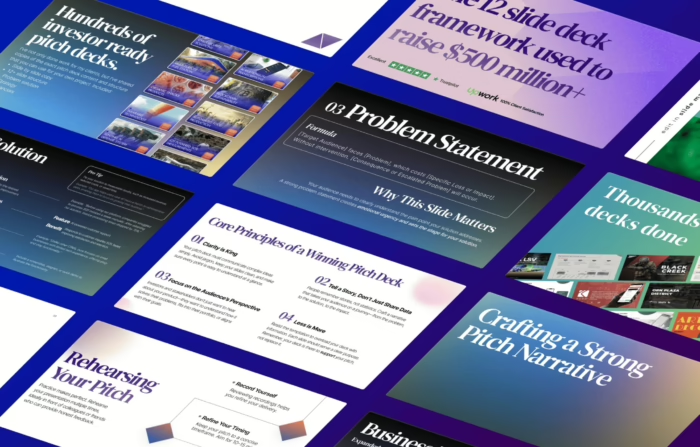
Get an investor ready pitch deck that gets you funded and saves over 30 hours of your time.
Join 100s of successful entrepreneurs who’ve transformed their pitch decks by using my hands-off approach, which includes: market research, copy, design, financials, narrative and strategy.
1 week turnaround time and less. Special pricing for early stage companies.
The least you will get on this call is 10 actionable tips & strategies to own that next pitch, worth $599, for free.

16 Slide Software Pitch Deck Template | Google Slides
The above is is just a simplified pitch deck version developed as part of our entrepreneurship program for graduate studies.
Founders that are serious about getting the funding they need, opt in for a deck has industry specific content, superb narrative and award winning design like these ones below:









I can help you build that deck with my hands-off process in 7 days or less.
Book a free 30 minute call below if you’re serious about getting an investor ready deck, and we’ll discuss your needs in detail. I’ll help you design the deck, write the content, develop the narrative and flesh out the strategy with financials.

We help 15,000+ founders every month create better pitch decks.
Alternatively, get the custom template for just $69,99.As soon as the payment is processed I’ll send over a quick questionnaire and deliver the deck in 24 hours and less.

Follow us on social for the newest templates:
1. Introduction
Purpose: To provide an immediate and compelling snapshot of your software.
- Slide Elements:
- Company Logo: Place it prominently, preferably at the top or center.
- Tagline: A catchy and concise statement that sums up what your software does.
- Hero Image: A striking, high-quality image or graphic related to your software or the problem it solves.
- High-level Statement: A one-liner that provides a snapshot of your software’s value proposition.
Example Content: “Introducing ‘CloudSaver’ – The Next-Gen Cloud Storage Solution. Saving your digital world, one byte at a time.”
2. Problem Statement
Purpose: To set the stage by illustrating the existing pain point or gap in the market.
- Slide Elements:
- Real-world Scenario: A short anecdote or story that paints a picture of the common issue.
- Relevant Statistics: Data that backs up the prevalence or seriousness of the problem.
- Visuals: Graphics or images that highlight the issue – bar graphs, pain point illustrations, etc.
Example Content: “82% of businesses struggle with fragmented cloud storage solutions, leading to inefficiency and data loss. Ever lost a crucial file amidst digital clutter?”
3. Solution
Purpose: To introduce your software as the answer to the previously highlighted problem.
- Slide Elements:
- Software Demo or Glimpse: A brief GIF or video snippet showing your software in action.
- Key Features: Bullet points or icons representing the main features.
- Benefit Statement: Highlight the immediate value for users.
Example Content: “CloudSaver consolidates, optimizes, and secures all your cloud data. Features include automated sorting, cross-platform access, and military-grade encryption. Simplify storage, enhance accessibility.”
4. Market Opportunity
Purpose: To showcase the potential growth and demand for your solution.
- Slide Elements:
- Market Size: A figure that shows the total addressable market.
- Target Audience Profile: Brief demographics and psychographics of your primary user base.
- Growth Projections: Charts or graphs illustrating potential growth in the sector or demand.
Example Content: “The global cloud storage market is projected to reach $137.3 billion by 2025. With 3.2 billion digital users worldwide seeking seamless solutions, CloudSaver taps into a growing, urgent need.”
5. Business Model
Purpose: To clarify how your software generates revenue and potentially profits.
- Slide Elements:
- Pricing Strategy: Outline the cost for end-users or businesses. Mention any tiered pricing or freemium models.
- Sales Channels: Identify through which mediums you’ll be selling – direct online sales, B2B partnerships, App Stores, etc.
- Revenue Streams: Highlight any secondary revenue streams, such as advertising, affiliate partnerships, or premium features.
Example Content: “CloudSaver offers three tiers: Free, Pro ($9.99/month), and Business ($49.99/month). Direct sales via our website comprise 70% of purchases, while partnerships with tech firms account for the remainder. Premium integrations offer additional monetization opportunities.”
6. Traction
Purpose: To showcase your current progress and momentum in the market.
- Slide Elements:
- User Growth: A chart or graph showing the increase in user adoption over time.
- Key Metrics: Highlight metrics like Monthly Active Users (MAUs), conversion rates, or retention rates.
- Testimonials/Reviews: Showcase any praise or positive feedback from early users or beta testers.
Example Content: “In just six months, CloudSaver has secured over 10,000 active users with a retention rate of 85%. One early adopter mentioned, ‘CloudSaver revolutionized my digital workspace. I can’t imagine going back.’ “
7. Go-to-Market Strategy
Purpose: To explain how you plan to launch or expand your software’s presence in the market.
- Slide Elements:
- Marketing Tactics: Overview of your promotional methods, e.g., social media campaigns, content marketing, or pay-per-click advertising.
- Sales Strategy: Touch upon any direct sales approaches, partnerships, or affiliate programs.
- Distribution Channels: Identify platforms or partners that will help you get your software into users’ hands.
Example Content: “CloudSaver’s multi-pronged approach includes aggressive content marketing to educate users, partnerships with established tech bloggers for reviews, and launching on platforms like the Google Play Store and Apple App Store for wider accessibility.”
Hold on. You might want to check my list on the best presentation and communication books...
These are crucial books that will help you improve the design and structure of your decks and presentations, besides improving your delivery and skyrocketing your confidence when facing investors. Check them out below.

8. Competitive Landscape
Purpose: To acknowledge your competition and convincingly differentiate your software.
- Slide Elements:
- Competitive Matrix: A table or chart comparing key features or benefits of your software versus main competitors.
- Unique Selling Proposition (USP): Highlight what truly sets your software apart.
- Barriers to Entry: If any, what are the obstacles or challenges for others trying to replicate your success?
Example Content: “While several cloud storage solutions exist, CloudSaver uniquely offers cross-platform automated sorting and unparalleled encryption. Our proprietary sorting algorithm, backed by a pending patent, ensures a competitive edge in the market.”
9. Team
Purpose: To showcase the talent and expertise behind the software, building trust and credibility.
- Slide Elements:
- Team Photos: Preferably professional shots of core team members.
- Brief Bios: Highlighting key qualifications, past successes, or relevant experience.
- Roles: Clearly state who handles what within the team.
Example Content: “Meet the Minds Behind CloudSaver: Jane Doe, CEO: Ex-IBM strategist with 10 years in cloud computing. John Smith, CTO: Former lead developer at Dropbox, passionate about secure storage solutions. Amy Lee, CMO: Marketing maven with a track record of scaling SaaS products to millions.”
10. Financial Projections
Purpose: To provide a glimpse into the potential financial success of the software.
- Slide Elements:
- Revenue Forecast: Projected revenue for the next 3-5 years.
- Key Assumptions: Basis for your projections, such as user growth rate or average revenue per user.
- Break-even Point: Highlight when you expect the company to start turning a profit.
Example Content: “By 2026, CloudSaver projects an annual revenue of $5M, driven by a consistent 8% MoM user growth and premium feature adoption. We anticipate a break-even point by Q4 2024.”
11. Funding Ask
Purpose: Clearly state what you’re asking from investors.
- Slide Elements:
- Amount Requested: The specific capital you’re seeking.
- Equity/Return Offer: What you’re offering in return, be it equity, convertible note terms, or another structure.
- Funding Use: Briefly explain where the investment will be channeled.
Example Content: “Seeking a $2M investment for a 10% equity stake in CloudSaver. Funds will primarily be allocated to R&D (60%), marketing (30%), and talent acquisition (10%).”
12. Vision and Future Plans
Purpose: To inspire and give investors a sense of the larger picture and potential long-term growth.
- Slide Elements:
- Product Roadmap: Upcoming features or enhancements planned for the software.
- Market Expansion: Any plans for entering new geographies or verticals.
- End Goal: What’s the ultimate vision for the software or company?
Example Content: “CloudSaver’s horizon is vast. With plans to integrate AI-based file recommendations by 2025 and expanding to serve enterprises in the APAC region by 2026, our vision is a world where digital storage is not just seamless but intelligent.”
13. User Testimonials & Case Studies
Purpose: To provide real-world validation of your software’s value and impact.
- Slide Elements:
- Testimonial Quotes: Select impactful statements from satisfied users or clients.
- Before-and-After: Showcase tangible benefits users experienced post-adoption.
- Logos: If applicable, brand logos of notable companies or clients using your software.
Example Content: “Real People. Real Impact. ‘CloudSaver transformed our workflow. Seamless, secure, and so intuitive!’ – Alex, Project Manager at TechWave Major partners include NexusTech, InnoWork, and AlphaNet.”
14. Risks & Challenges
Purpose: To be transparent about potential obstacles, demonstrating honesty and forward-thinking.
- Slide Elements:
- Identified Risks: Mention any anticipated challenges, e.g., technical hurdles, market adoption, etc.
- Mitigation Plans: Highlight the steps or strategies you’ve outlined to address these risks.
Example Content: “Every journey has its challenges. We foresee potential hurdles in broadening to non-tech industries. However, with targeted education campaigns and bespoke integration options, we’re poised to navigate these waters effectively.”
15. The Ask Recap
Purpose: To reiterate your request, driving home the main points of your pitch.
- Slide Elements:
- Reminder of Funding Ask: Refresh on the investment amount and terms.
- Closing Note: A persuasive and compelling statement or vision.
Example Content: “To recap, we’re seeking $2M for a 10% equity stake. Join us in shaping the future of cloud storage, making it smarter, more secure, and universally accessible.”
16. Thank You & Questions
Purpose: To conclude the presentation on a gracious note and open the floor for discussion.
- Slide Elements:
- Thank You Note: A simple acknowledgment of the audience’s time and consideration.
- Contact Information: Ensure investors know how to reach out for further discussions.
- Q&A: Explicitly open the space for any queries or clarifications.
Last Words
And that’s it! No smoke, no mirrors—just practical steps to make sure your software pitch hits home. Remember, the key isn’t about dazzling people with complex slides or data dumps. It’s about connecting, solving a problem, and making your audience feel like they need your solution—right now.
I’ve helped others close deals with these tactics, and now it’s your turn. Keep it simple, keep it clear, and don’t forget to inject a bit of you into the process.
Good luck out there, and if you need a hand, you know where to find me. You got this!
But if you don’t got it:
Join hundreds of successful entrepreneurs who’ve transformed their pitch decks with my help.
Let me develop an investor ready deck by using my hands-off approach, which includes: market research, copy, design, financials, narrative and strategy.
One week turnaround time.
The least you will get is 10 actionable tips & strategies to own that next presentation, worth $599, for free.

If you want to really dive into the world of pitch decks, check out our complete collection of pitch deck templates.
Related SaaS Pitch Deck Templates
Check out our massive directory of pitch deck templates, or the following related templates:
10 Slide Global Employment Solutions Pitch Deck Template | Google Slides
You’re all set to build a dream team across borders—ready to hire…
11 Slide Data and Risk Intelligence Pitch Deck Template | Google Slides
So, here’s the deal: you’ve got a killer concept for a data…
11 Slide Data Observability Pitch Deck Template | Google Slides
You’ve got the next big thing in data—seriously, your insights could save…
12 Slide B2B Data Solutions Pitch Deck Template | Google Slides
Alright, let’s cut to the chase. You’ve got reams of data, endless…
15 Slide EdTech Pitch Deck Template | Google Slides
So, you’ve built an app that’s going to change education forever, right?…
13 Slide Open-Source Bi-Solutions Template | Google Slides
You’re probably here because you’ve got an idea that could change the…
Looking for a step by step guide to build a SaaS pitch deck?
Check out our in-depth SaaS pitch deck guide.
Check out some of the essential 101 guides:
The Dreaded Financial Projections Slide in a Pitch Deck: What’s The Secret?
This is the ideal pitch deck length + exact slides Author: ViktorPitch Deck Expert. Ex…
The Role of Emotional Storytelling in Pitch Decks
Why Color Psychology in Pitch Decks Matters More Than You Think
This is the ideal pitch deck length + exact slides Author: ViktorPitch Deck Expert. Ex…
How to Design a Visually Stunning Investor Pitch Deck + Template
This is the ideal pitch deck length + exact slides
This is the ideal pitch deck length + exact slides Author: ViktorPitch Deck Expert. Ex…
Mastering the Financial Projections Slide: Turning First Impressions into Lasting Opportunities
You’re convinced your startup is the next big thing, but somehow, your pitch keeps landing…

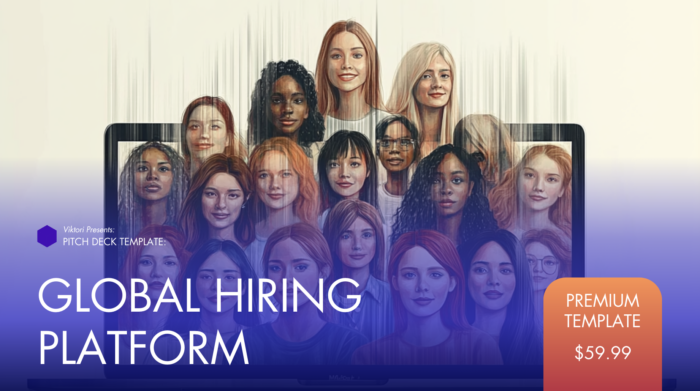
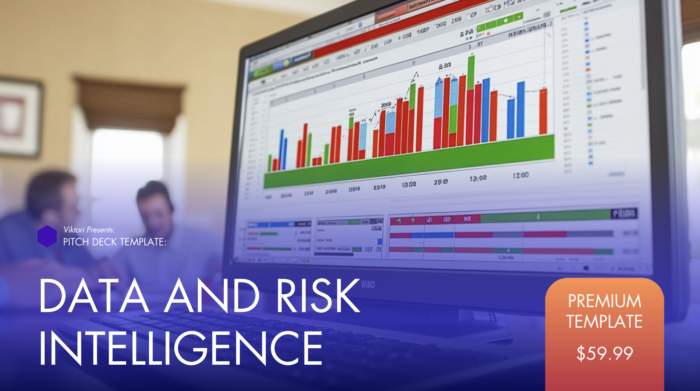
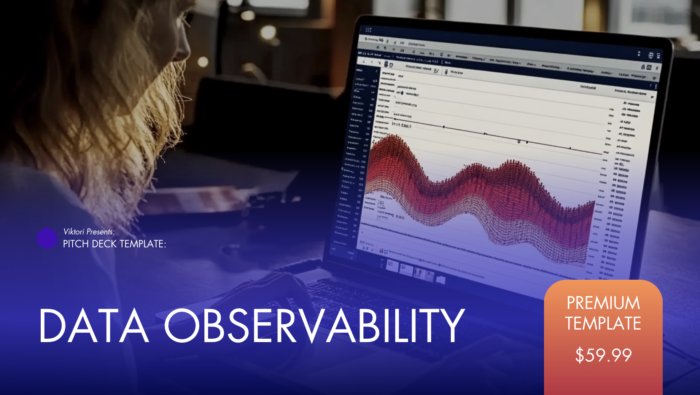
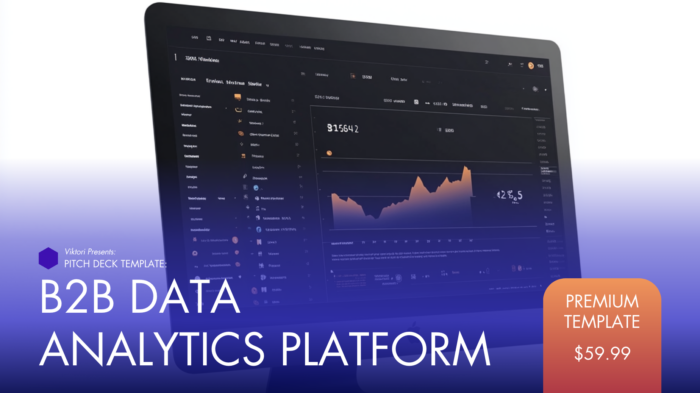
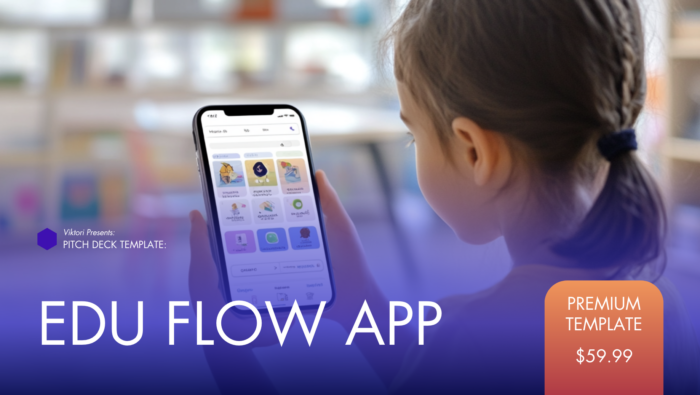
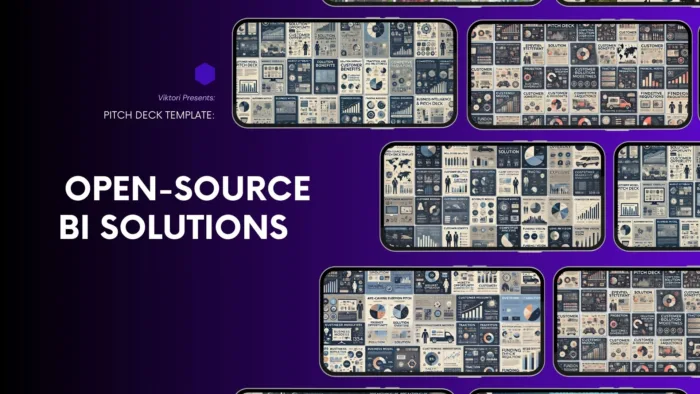

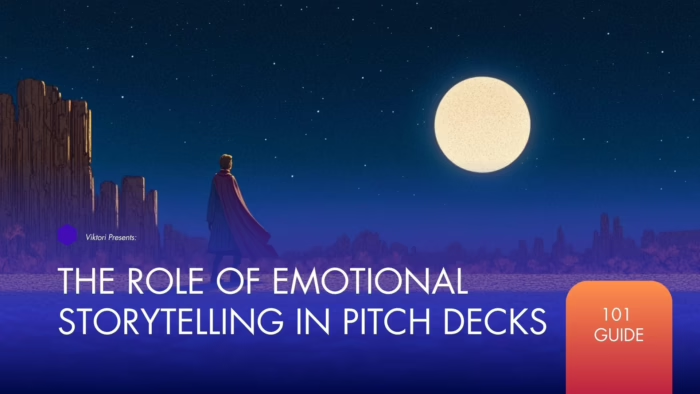

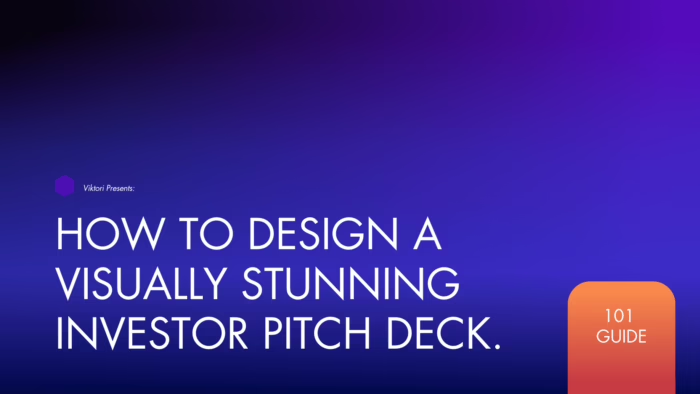

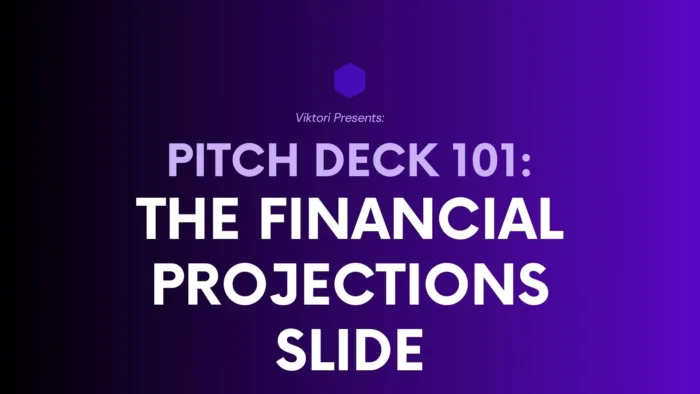

Comments are closed.